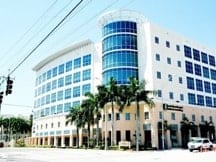Ankle Fracture Surgery
Book Your Free Consultation
What is ankle fracture surgery?
An ankle fracture can range in severity from a thin crack to a shattered or crushed bone. Because we depend so heavily on the intricate coordination of all the delicate bones that make up our foot’s mechanisms, an injury that might seem minor still needs to be taken seriously. Because elements of the foot operate like an elaborate belt and pulley system, each bone, ligament, and tendon are depended upon to make the whole foot function optimally. The following is a breakdown of the most common ways to refer to various bone fractures:
- Closed fracture:bone does not break through the skin
- Open fracture (or compound fracture):bone protrudes from the skin
- Hairline fracture:a thin crack in the bone
- Single fracture:breakage in one location only
- Segmental fracture:breakage in two locations
- Comminuted fracture:breakage into multiple pieces
- Displaced fracture:breakage into uneven pieces, making realignment difficult
- Non-displaced fracture:breakage into fairly even pieces, making realignment easier
- Greenstick fracture:bone has broken on one side and is bent on the other
- Torus fracture:bone has broken on one side, causing a bump on the other side
If there is bone protruding from your skin, it’s easy to see the fracture, but there are many kinds of ankle fractures, most under the skin. You could have a single break or several. You could have a hairline fracture or a serious displaced fracture.
The pain of a facture is intense, and you may lose the ability to move your foot completely. Never try to fix a possible fracture on your own. If you’ve had an injury to the ankle, you need to see a doctor. But fractures can also be caused by osteoporosis and overuse. Don’t wait for an injury to heal on its own. You don’t want to take any chances where your ankle and feet are concerned.
Causes
Fractures can be caused by a wide variety of activities or situations.
Trauma is a common culprit. Fractures from trauma are typically caused by bearing all the weight of a fall on the ankle, a vehicular accident, or a sports injury.
Osteoporosis can lead to fractures because bones are weakened by this condition and more easily broken by minor stressors.
Overuse is another cause because when muscles fatigue from overuse, the pressure on the bone may be strong enough to cause a fracture.
Sign & Symptoms
Signs and symptoms of ankle injuries and fractures tend to be obvious.
- Pain is the most common complaint.
- Usually, pain is not felt from the exact area of the fracture.
- You may experience associated fractures of your foot knee that also cause pain.
- Pain in the ankle hinders you from walking.
- Swelling frequently occurs around the ankle too.
- Swelling suggests either soft tissue damage with possible blood around the joint or fluid – possible blood – within the joint itself.
- You may see bruising around the joint.
- In severe fractures you may see obvious deformities of bones around the ankle.
- Your skin may be stretched over an underlying broken bone.
- You may see actual exposed bone.
- If you injure nerves or blood vessels that supply your foot, you may experience even more pain along with pale skin in the foot, numbness, or inability to move your foot or toes.
Time is of the essence in stabilizing the ankle to avoid further injury, more swelling, and internal or external bleeding.
If you think you have broken your ankle, the first step is to immobilize the affected area and get to a doctor or ER for evaluation. While you are in transit, a makeshift splint like a rolled magazine may help keep a broken ankle supported. Keeping your ankle raised and gently applying ice is helpful in reducing swelling, making treatment easier.
In the ER or primary care office, an X-ray may be ordered, or an MRI if soft tissue damage is suspected. Treatment of fractured bones falls into these broad categories:
- Stabilize/immobilize for self-healing (hairline fractures and some simple fractures can be treated this way)
- Realign bones by manipulationin the case of closed, non-displaced fractures with one and sometimes two fracture sites may be candidates
- Surgically realign bonesin the case of non-displaced fractures
- Surgically realign or repair bones(sometimes with the use of bone grafts) by using hardware such as pins, screws, plates, or wires, temporarily or permanently, to hold bone alignment in place.
Recovery
Casts, splinting, and other appliances and aids are used in various combinations to allow fractures and joint dislocations to heal. This usually takes 3-6 weeks, depending on the nature and location of the break, as well as the age and overall health of the patient.
Dr. Ray Lopez
Minimally Invasive Bunion Surgery

- Main Office:
- Miami Beach 400 Arthur
- Godfrey Road Suite #412
- Miami Beach, FL 33140

- South Miami
- 6200 Sunset Drive Suite #402
- South Miami, FL 33143

- Pembroke Pines
- 601 N. Flamingo Road
- Suite #101, Pembroke Pines, FL 33028

- Aventura
- 21000 NE 28th Ave.
- Suite #203, Aventura, FL 33180





